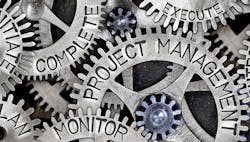Filed and forgotten, that’s the fate of too many proposals I’ve had to work on. Usually, they relate to somebody’s pet project, an itch that production wanted to scratch, or a worthwhile concept that proved uneconomic. I’m kept busy for a week or two developing the scope, estimating the cost and laying out the schedule. Then, when eyes pop over the price, the project is entombed in a folder.
However, every so often, a need appears, funding is found, and the fun begins. The situation can become intense where regulators are involved or a project suddenly becomes crucial to the company.
The first challenge is budget. Nobody in management seems to grasp the major dent inflation can make in a project budget developed just a few years earlier. One project I scoped in the early 1980s was revived five years later; the original budget wasn’t anywhere near adequate. Inflation has an impact even at 2%/y, the annual rate for the past 20 years. In a hot economy, things are much worse.
The second challenge is that a plant environment seldom is static. Equipment is moved and other equipment is added. There’s also the little matter of priorities. Is your project important enough to justify moving a tank, pump, pipe or even a wall out of the way? It’s not just the money — plant politics come into play.
So, how do you address these problems and keep your job? Start with a new scope if goals differ from the original ones. If the scope is the same, then skip this step.
Never assume the original design was sound. Spend some time getting to know the equipment or process. Talk to the project originator and the stakeholders. You may find the objectives are unachievable or the project manager or equipment provider stretched the truth on what was possible. Also, check if the plant is okay with the status quo and how it copes with whatever issues the proposal addresses. If so, the project really isn’t needed and should go back into the file drawer.
Next, look at the real estate and the technology. Hopefully, you have a detailed schedule showing how the work was to be accomplished. Check access, e.g., for cranes, etc., in the current layout. Can you still move equipment around as originally planned? Has the space for your equipment now been filled? Can you move what’s there? Someone must tell you what must stay and what can move. Finding who’s really in charge often is hard and likely will blow your donut budget for meetings. If you can’t move something in the way, temporarily or otherwise, you may have to reinter the project.
In addition, always keep in mind that other things may have changed, e.g., plant standards for pipe, materials, etc.; utilities, i.e., water, steam, air and nitrogen; and the state-of-the-art in equipment. Is there a better way to accomplish the goals of the project? Remember desalination? Nobody’s laughing about it like they did in the 1980s. Advances in instrumentation and control technology occur at a fast pace — does your project take advantage of what’s now available?
Don’t assume the suppliers are still around. Make some phone calls not just to confirm that but to see if the original people dealt with remain. I try to buy from vendors or fabricators located close enough that I can visit their shops. Every time I’ve had to rely on inspectors, especially ones overseas, I’ve found things get missed and some last-minute modifications are required; this is a common problem with pressure vessels.
You also may find that engineering has changed. Years ago, vessel fabricators did the ASME code work. Today, you have to find an engineering shop that still maintains its license. Or, in the case of a non-coded vessel, you can do it yourself if you’ve got the time. Then, there’s what I call equilibrium. Seldom is a project scope the same as it started out in basic engineering. When some manager tells me that projects are sequential, I laugh because that’s a recipe for disaster. Equilibrium takes time and buy-in. The most successful projects are ones that bring everyone together during the kick-off meeting and allow the design to evolve until it meets the project goals and makes completion as easy as possible.
About the Author

Dirk Willard
Contributing Editor
DIRK WILLARD is a former ASBPE award-winning columnist for Chemical Processing's Field Notes column. During his 10+ years as a contributing editor for CP, he wrote hundreds of valuable and insightful pieces on design and operational issues. He retired in 2023.
